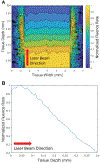Computational Simulations for Infrared Laser Sealing and Cutting of Blood Vessels
- PMID: 33746498
- PMCID: PMC7978229
- DOI: 10.1109/jstqe.2020.3045912
Computational Simulations for Infrared Laser Sealing and Cutting of Blood Vessels
Abstract
Blood vessel burst pressures were simulated and predicted for sealing and cutting of vessels in a two-step process, using low (<25 W), medium (~100 W), and high (200 W) power lasers at a wavelength of 1470 nm. Monte Carlo optical transport, heat transfer, Arrhenius integral tissue damage simulations, and vessel pressure equations were utilized. The purpose of these studies was to first validate the numerical model by comparison with experimental results (for low and medium power) and then to use the model to simulate parameters that could not be experimentally tested (for high power). The goal was to reduce the large range of parameters (power, irradiation time, and linear beam dimensions) to be tested in future experiments, for achieving short vessel sealing/cutting times, minimal bifurcated seal zones (BSZ), and high vessel burst pressures. Blood vessels were compressed to 400 μm thickness. A wide range of linear beam profiles (1-5 mm widths and 8-9.5 mm lengths), incident powers (20-200 W) and clinically relevant irradiation times (0.5-5.0 s) were simulated and peak seal and cut temperatures as well as thermal seal zones, ablation zones, and BSZ computed. A simplistic mathematical expression was used to estimate vessel burst pressures based on seal width. Optimal low-power parameters were: 24W/5s/8×2mm (sealing) and 24W/5s/8×1mm (cutting), yielding a BSZ of 0.4 mm, corresponding to experimental burst pressures of ~450 mmHg. Optimal medium-power parameters were: 90W/1s/9.5×3mm (sealing) and 90W/1s/9.5×1mm (cutting), yielding a BSZ of 0.9 mm for burst pressures of ~1300 mmHg. Simulated only optimal high-power parameters were: 200W/0.5s/9×3 mm (sealing) and 200W/0.5s/9×1mm (cutting), yielding a BSZ of 0.9 mm and extrapolated to predict a seal strength of ~1300 mmHg. All lasers produced seal zones between 0.4-1.5 mm, corresponding to high vessel burst pressures of 300-1300 mmHg (well above normal systolic blood pressure of 120 mmHg). Higher laser powers enable shorter sealing/cutting times and higher vessel strengths.
Keywords: ablation; blood vessel sealing; coagulation; laser.
Figures






Similar articles
-
Sealing and Bisection of Blood Vessels using a 1470 nm Laser: Optical, Thermal, and Tissue Damage Simulations.Proc SPIE Int Soc Opt Eng. 2021 Mar;11621:1162108. doi: 10.1117/12.2576795. Epub 2021 Mar 5. Proc SPIE Int Soc Opt Eng. 2021. PMID: 34305258 Free PMC article.
-
Rapid sealing and cutting of porcine blood vessels, ex vivo, using a high-power, 1470-nm diode laser.J Biomed Opt. 2014 Mar;19(3):38002. doi: 10.1117/1.JBO.19.3.038002. J Biomed Opt. 2014. PMID: 24658792
-
Comparison of fiber-optic linear beam shaping designs for laparoscopic laser sealing of vascular tissues.Opt Eng. 2022 Feb;61(2):026112. doi: 10.1117/1.oe.61.2.026112. Epub 2022 Feb 26. Opt Eng. 2022. PMID: 36711441 Free PMC article.
-
Infrared laser thermal fusion of blood vessels: preliminary ex vivo tissue studies.J Biomed Opt. 2013 May;18(5):58001. doi: 10.1117/1.JBO.18.5.058001. J Biomed Opt. 2013. PMID: 23640080
-
[Types of medical lasers].Med Pregl. 1998 Mar-Apr;51(3-4):146-50. Med Pregl. 1998. PMID: 9611958 Review. Croatian.
Cited by
-
Comparison of quartz and sapphire optical chambers for infrared laser sealing of vascular tissues using a reciprocating, side-firing optical fiber: Simulations and experiments.Lasers Surg Med. 2023 Dec;55(10):886-899. doi: 10.1002/lsm.23740. Epub 2023 Nov 27. Lasers Surg Med. 2023. PMID: 38009367 Free PMC article.
-
Nondestructive optical feedback systems for use during infrared laser sealing of blood vessels.Lasers Surg Med. 2022 Aug;54(6):875-882. doi: 10.1002/lsm.23548. Epub 2022 Apr 7. Lasers Surg Med. 2022. PMID: 35391495 Free PMC article.
-
A review on hybridization of plasmonic and photonic crystal biosensors for effective cancer cell diagnosis.Nanoscale Adv. 2023 Nov 1;5(23):6382-6399. doi: 10.1039/d3na00541k. eCollection 2023 Nov 21. Nanoscale Adv. 2023. PMID: 38024311 Free PMC article. Review.
-
Reciprocating Side-Firing Fiber for Laser Sealing of Blood Vessels.Proc SPIE Int Soc Opt Eng. 2022 Jan-Feb;11936:1193602. doi: 10.1117/12.2605599. Epub 2022 Mar 3. Proc SPIE Int Soc Opt Eng. 2022. PMID: 35965612 Free PMC article.
-
A Real-Time Fluorescence Feedback System for Infrared Laser Sealing of Blood Vessels.IEEE J Sel Top Quantum Electron. 2023 Jul-Aug;29(4 Biophotonics):7200407. doi: 10.1109/jstqe.2022.3221338. Epub 2022 Nov 11. IEEE J Sel Top Quantum Electron. 2023. PMID: 36466144 Free PMC article.
References
-
- Ding Z, Wable M, and Rane A, “Use of Ligasure bipolar diathermy system in vaginal hysterectomy,” J. Obstet. Gynaecol, vol. 25, no. 1, 2005, pp. 49–51. - PubMed
-
- Levy B and Emery L, “Randomized trial of suture versus electrosurgical bipolar vessel sealing in vaginal hysterectomy,” Obstet. Gynecol, vol. 102, no. 1, 2003, pp. 147–51. - PubMed
-
- Leonardo C, Guaglianone S, De Carli P, Pompeo V, Forastiere E, and Gallucci M, “Laparoscopic nephrectomy using Ligasure system: preliminary experience,” J. Endourol, vol. 19, no. 8, 2005, pp. 976–978. - PubMed
-
- Manasia P, Alcaraz A, and Alcover J, “Ligasure versus sutures in bladder replacement with Montie ileal neobladder after radical cystectomy,” Arch. Ital. Urol. Androl, vol. 75, no. 4, 2003, pp. 199–201. - PubMed
-
- Romano F, Gelmini R, Caprotti R, Andreotti A, Guaglio M, Franzoni C, Uggeri F, and Saviano M, “Laparoscopic splenectomy: ligasure versus EndoGIA: a comparative study,” J. Laparoendosc. Adv. Surg. Tech. A, vol. 17, no. 6, 2007, pp. 763–767. - PubMed
Grants and funding
LinkOut - more resources
Full Text Sources
Other Literature Sources
